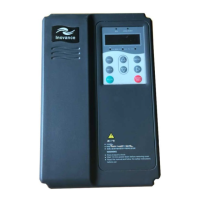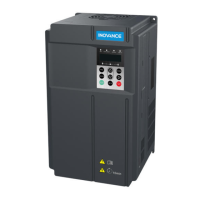keyboard (or UP and DOWN of multifunctional input terminals).
“Recorded” means that the setup frequency upon restart of inverter due to power failure
remains the same.
2
:
AI1 3:AI2 4:AI3
It means that the frequency is determined by the analog input terminal. Standard unit provides
two analog input terminals, and optional I/O expansion card can provide one analog input
terminal (Al3). AI1 and AI3 refer to voltage input of 0 to 10V. AI2 can be used as either voltage
input of 0V to10V or current input of 4mA to 20mA, which can be selected by the J3 jumper on
the control board.
5: Pulse given (Dl5)
The frequency setup is given by the terminal pulse.
Pulse reference signal specication: voltage range of 9V to 30V and frequency range of 0kHz
to 50kHz.
Caution: Pulse given can only be input from the multifunctional input terminal DI5.
6. MS speed
Select MS speed running mode. It needs to set Group F4 “Input Terminal” and Group FC “MS
Speed and PLC” parameters to determine the relative relationship between the reference signal
and the reference frequency.
7:Select simple PLC mode. When the frequency source is simple PLC, it needs to set Group
FC “MS Speed and PLC” parameters to determine the reference frequency.
8: PID
Select process PID control. In this case, it needs to set Group FA “PID Function”. The running
frequency of the inverter is that after PID functions. For the meanings of PID reference source,
reference quantity and feedback source, please refer to Group A “PID Function”.
9: Communication reference
It means that the main frequency source is given by the host computer via the communication
mode.

